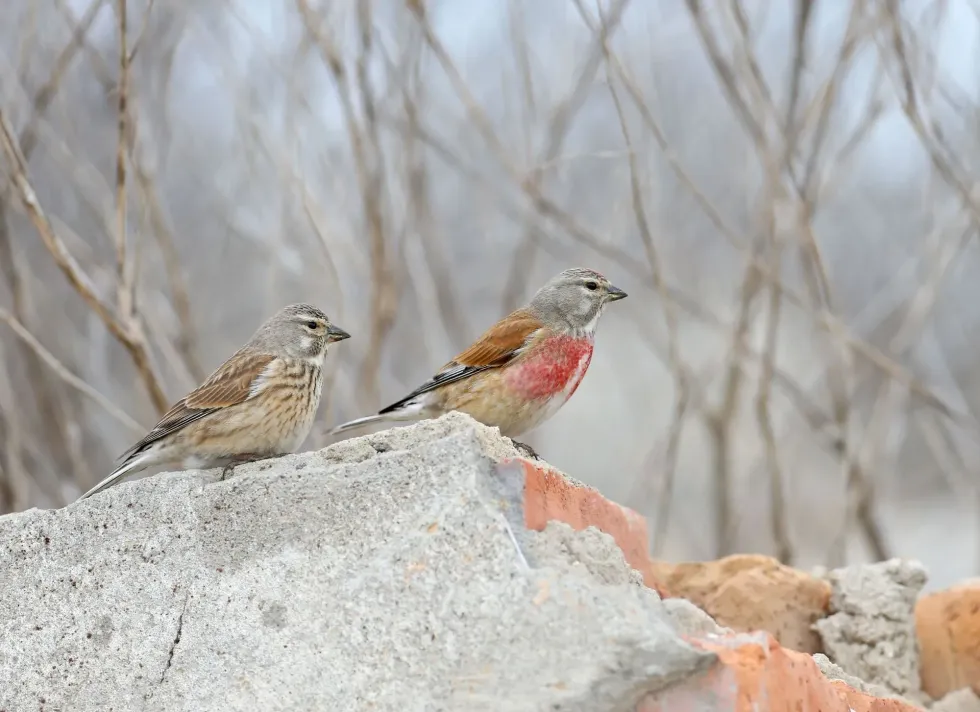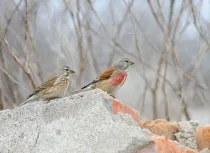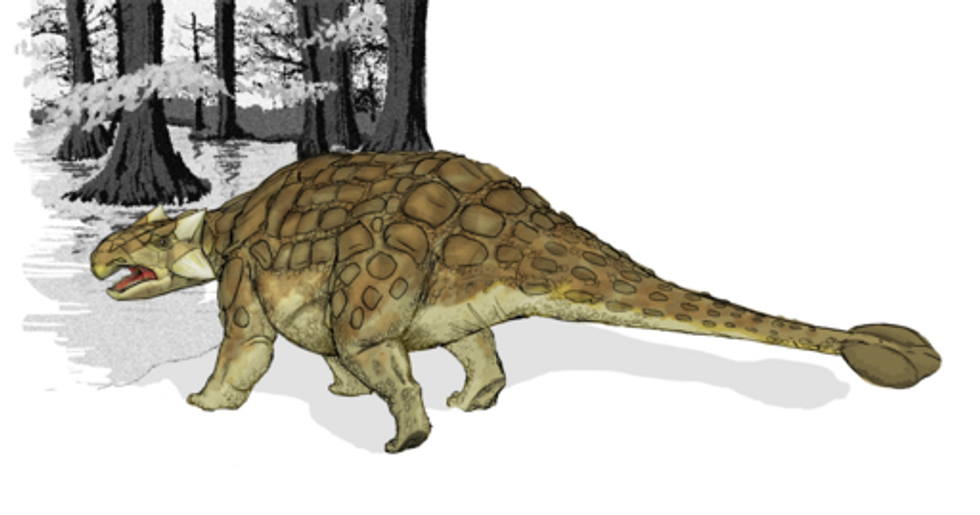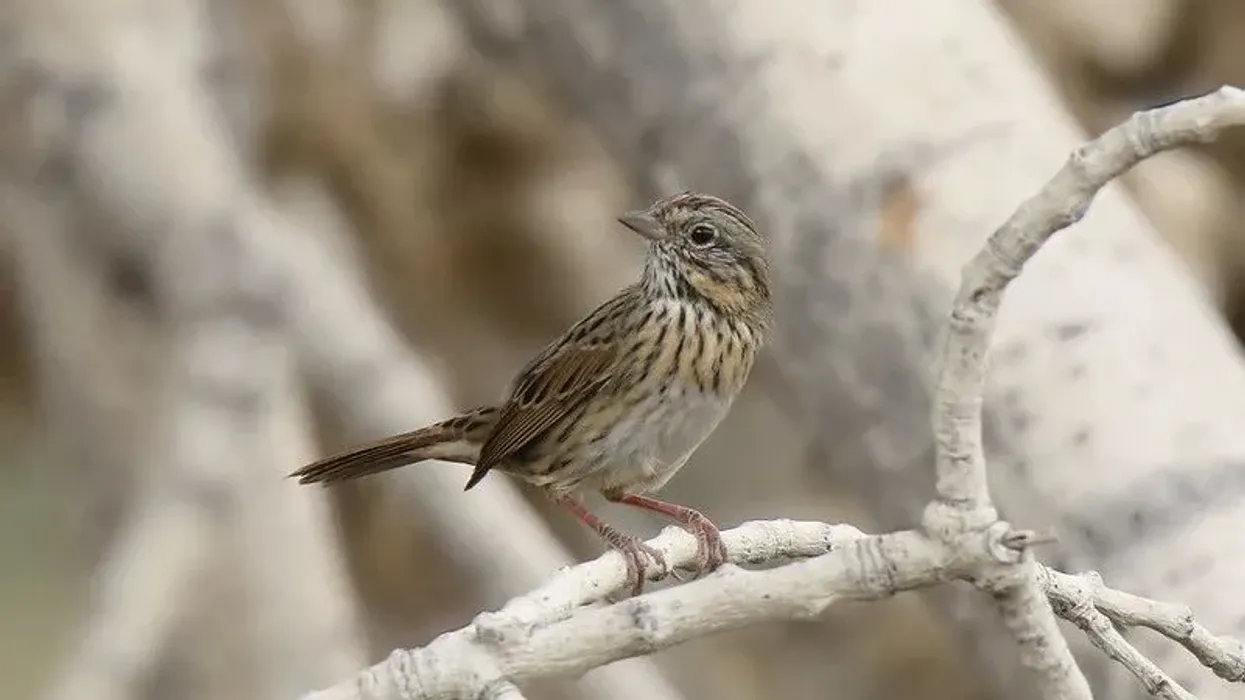The common linnet is a small bird that is seen usually during the winter season. It is a 'cage bird' that has a beautiful voice. They are famous for their seed-eating behavior.
It stays in large flocks often seen on the top of bushes during its breeding season. It belongs to the category of finches that are a common occurrence in heathland, scrub, and farmland. It nests in scrub, gardens, hedgerows, and fields.
During the summer, the adult male's plumage becomes vibrant to captivate a female bird. This behavior is displayed to ensure his recognisability as a member of the finch family.
On the other hand, the adult male's winter plumage is a tad less vibrant with a dark brown head. The pink color of the breast is also considerably washed. This is one of the most interesting attributes of this bird.
The female birds are responsible to collect the material to build the nest while being guarded by the male birds. The female birds then build the nest in a very low region above the ground in the thorny, dense bush, hedge, and very rarely in woodpiles.
The nest is made with twigs, roots, moss, and plant fibers and in the shape of a cup. The nest is filled with fur and feathers.
If you like what you read, do check out our fact files on hornbill facts and keel-billed toucan facts.
Common Linnet Interesting Facts
What type of animal is a common linnet?
The common linnet (linaria cannabina) is a tiny bird with a pointed bill that is famous for its soulful singing.
What class of animal does a common linnet belong to?
It belongs to the class of 'Aves' which includes birds.
How many common linnets are there in the world?
According to the IUCN Red List, the number of this species is somewhere between 50,000,000-99,999,999. But their population is significantly decreasing and they are vulnerable.
Where does a common linnet live?
It is native (endemic) to Europe, West Asia, and North-West Africa. Farmlands, fields, hedgerows, scrublands, orchards, and parks are all home to the common linnet. They are migratory in nature.
What is a common linnet's habitat?
As far as the habitat of this bird is concerned, its distribution includes a wide variety of places such as hills with scattered trees, bushes, cleared forests and edges, borders of agricultural land, lowland, heathland. Also, their distribution can be sighted in more common places like parks, public gardens, and orchards.
During the non-breeding season, they can be sighted in coastal dunes, salt marshes, and along sidelines. Their habitats are usually below 1.2 mi (2 km) of elevation, but during the breeding season, they go up to 1.4-2.2 mi (2.3-3.6 km) according to the range.
Who do common linnet live with?
This bird stays in flocks and seeing this finch with serins a European and North African bird belonging to the family of 'Fringillidae', is a common sight during winter.
How long does a common linnet live?
The average lifespan of this bird is two years. However, the longest surviving linnet has lived up to eight years and 3 months in the year 1975.
How do they reproduce?
This species breed in a wide variety of natural habitats ranging from coastal areas with gorse to rough grasslands and uplands. They are usually monogamous and territorial and seen in small flocks during the breeding season.
However, the bonds last just for the season. During the breeding season, these pairs are seen protecting the nesting space and a small perimeter around that space.
Within the pair bonds, one behavior is typically observed.
The male of the pair is seen in engaging courtship behavior such as ruffling the feathers of the crown and breast to flash the crimson patches; dropping the wings and fanning their tails while swaying slightly from one side to the other; singling loudly and jumping around the female partner; feeding the female partner regularly, even during the incubatory period.
What is their conservation status?
According to the IUCN Red List, they are listed under 'Least Concern'. However, their population is decreasing and efforts for their conservation are being made by various organizations to save them from extinction.
Common Linnet Fun Facts
What do common linnet look like?
This bird has a gray head and the underparts of the body, the chin, and the throat are white-colored. The top portion and the sides of the breast are colored red.
The sides of the belly are brown in color. The Centre of the breast and top portion of the belly are either buff or pink. This bird has got white wings.
During the breeding season, the upper parts of males of this species are brown in color. The underparts of the body are dull red in color.
The tail of this species is black with feather-like ends buff in color. The upper parts of the wings are normally chestnut brown in color, unlike the coverts on the outer part, which are black in color and narrow-shaped. The primary coverts are white in color, but the secondary and tertiary coverts are brown in color.
A red spot on the front part of the crown is present, which makes them easy to identify. The bill of these finches is black in color with a gray base. The eyes of these finches are dark brown in color. Legs and feet are light brown in color.
One striking difference between males and female is that the former has a pinkish-red forehead and chest while this lacks in females.

How cute are they?
This finch is a small and cute bird with a greyish head and white neck. It is known for its soulful song and is often kept in many homes because of this skill.
How do they communicate?
Common linnets have very loud voices. They communicate and express themselves by calls such as 'chit-chit-chit'. These seed-eating finches, sing while in flight with other finches as well as when they rest on the branches of trees.
How big is a common linnet?
These seed-eating finches are tiny in size and are 5.1-5.9 in (13-15 cm) in length almost the size of a Eurasian tree sparrow or a canary like the Atlantic canary.
How fast can a common linnet fly?
The linaria cannabina is a fast flyer. Its flying includes dancing that is evidently visible when they fly over the fields in flocks before making a landing. However, the exact speed of linnet (linaria cannabina) is not known, yet it can be concluded that they are pretty fast when it comes to flying.
How much does a common linnet weigh?
The body mass of a linnet (linaria cannabina) is 0.04 lb (20 g) which is slightly more than another member of the Passerellidae family, the chipping sparrow.
What are the male and female names of the species?
Unfortunately, there are no separate names assigned for the male and female species of this bird.
What would you call a baby common linnet?
These birds start breeding during the period between the month of April and August. They produce 2-3 broods every season. The baby of this bird is called a 'chick'. They nest for 10-14 days under the care of the parents. The eggs are pale blue in color and have brown marks on the surface.
What do they eat?
This species mainly thrives on plant matter. Their food primarily includes seeds, but also eat fruit and buds.
The seeds are also the primary food for its chicks, which includes kernels from wildflowers, crucifers, chickweeds, dandelions, thistle, as well as mayweed, groundsels, and hawthorns. Certain invertebrates, adult and larval insects that are found on the ground are often eaten by these birds.
Are they dangerous?
This species is charming, small, and amicable. They do not cause harm to anyone, hence they are not dangerous.
Would they make a good pet?
They are often called 'cage birds' as they are kept in many households and are seen singing their own melodious song.
Did you know...
The female bird species alone construct the nest for the young ones.
Common linnets (linaria cannabina) are monogamous species.
The adult male and female species feed and take care of the juvenile birds during the initial 10-14 days of nesting.
This seed-eating song bird likes feeding on cannabis apart from flax seeds.
The European species is called the 'Carduelis cannabina'. The scientific name 'Carduelis cannabina' has been derived from cannabis or marijuana which is a common food for these birds.
A famous musical band from the Netherlands was named after this bird. They also symbolize a lost way of life.
They exhibit a special behavior in winters and move around in mixed flocks, singing their own song.
There is a bird called Lynette too.
Where are linnets found?
These birds are present in most of the continents across the world, especially in Europe, in size different subspecies, and are seen in large flocks. They are found in places like Afghanistan, Algeria, Andorra, Austria, Azerbaijan, Belarus, Belgium, Bulgaria, Croatia, Cyprus, Czechia, Denmark, Egypt, Estonia, Finland, France, Germany, Greece, Hungary, and several other countries.
Therefore, they are seen all across Europe apart from other places.
This species breeds in countries like Albania, Armenia, Bosnia, and Herzegovina, China, Georgia, Israel, Kazakhstan, Kyrgyzstan, Liechtenstein, Montenegro, Norway, Poland, Russian Federation on scrubs and heathland.
What is the meaning of linnet in English?
The word linnet stems from the 16th-century old word 'lin' that denotes 'flax'. Since the favorite food of these birds is flax seeds, they are known by this name.
Here at Kidadl, we have carefully created lots of interesting family-friendly animal facts for everyone to discover! For more relatable content, check out these giant cowbird facts and ani bird facts for kids.
You can even occupy yourself at home by coloring in one of our free printable bird coloring pages.









